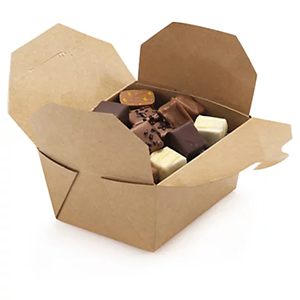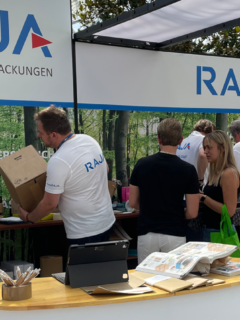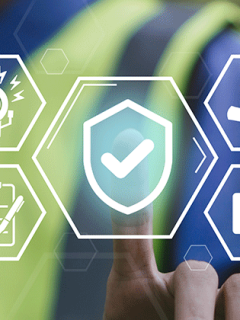Smart cities, smart homes, smart TVs, smartphones, smartwatches, smart packaging… the list is endless. So is everything smart these days or what? The term “smart” sounds fresh and modern – a good selling point in the product description.
Smart packaging – what is it?
Smart stands for clever, intelligent and describes the increasing networking of technologies that make life easier. Smart technologies already make it possible today, for example, to monitor the house remotely and to automate the heating or lighting with the help of sensors: The light goes on when you enter the room, the temperature is also controlled according to presence in order to reduce heating costs. Even roller blinds open and close depending on the incidence of light.
So far, so good. But what is smart packaging all about? Smart packaging is basically packaging with an extended function. There are two types to distinguish: Active packaging and intelligent packaging.
Active
packaging
Active packaging has a targeted effect on the contents. Either certain substances are released to the packaged product or they are withdrawn. Today, active packaging is mainly used in the food industry as well as in the cosmetics and pharmaceutical sectors. The active element can either be integrated into the packaging or added separately as an insert.
The
aims of using active packaging are:
- antimicrobial effect
- Aroma regulation
- Ethylene absorption
- Moisture regulation
- Light regulation
- Oxygen absorption
Protect packaging from moisture
A common application example is moisture regulating materials enclosed as small sachets,desiccant bags or similar. For packaged fresh meat products under protective gas, a suction insert is placed underneath to collect the escaping meat juice. This reduces germ multiplication. Packaging under protective gas such as carbon dioxide (CO2) or nitrogen (N2) serves to extend freshness and shelf life. This is because oxygen causes food to oxidise, accelerates the growth of microorganisms and causes food to spoil more quickly.
Since the active ingredients of the packaging do not have to be labelled, it is difficult for consumers to understand when and if active packaging is used. However, the following applies in principle: Only approved substances may be used.
Smart packaging
In contrast to active packaging, intelligent packaging does not affect the product, but offers an additional benefit. The additional benefit can, for example, be indicated by indicator functions and is communicated “intelligently” to the outside world. The sensors or indicators can be integrated into the packaging or attached to the packaging, inside or outside. Indicators are used in transport monitoring and show improper transport through discolouration, for example:
- Shocks
- Rotations
- Humidity
- Temperature fluctuation
This makes it possible to determine upon receipt of the goods whether critical limit values have been exceeded or not.
Smart packaging and Industry 4.0
Besides protecting the packaged products, intelligent packaging has other functions: Automation, sales promotion and information. Barcodes, QR codes, LEDs, NFC, loudspeakers, radio chips, augmented reality or displays can be used to integrate further additional benefits into the packaging.
Industry 4.0 refers to the comprehensive digitalisation of industrial production. This includes automated warehouse and logistics centres. All data is recorded and evaluated. This would be inconceivable without barcodes or RFID technology. Because with their help, quantity checks can take place, delivery routes can be tracked and quality controls can be carried out to optimise processes even further.
Logistics can be seen as a pioneer in the field of smart packaging: Seamless tracking of the transport route in real time has long been standard. In the future, this will give rise to even more ideas.
Extented Packaging
Extented Packaging refers to an additional benefit of the packaging through online information. Smartphone users receive additional information about the product with the help of a code on the packaging. Augmented reality is increasingly being used for food products to offer consumers suitable recipes, as in the case of Heinz ketchup:
Possible areas of application for smart packaging
Smart packaging is still in the very early stages of development, but it holds immense potential for the future. The biggest challenges today are the high manufacturing costs and the recycling of the packaging. When technical materials are attached to the cardboard, this becomes a problem. The cardboard belongs in the waste paper, but the technical parts belong in the hazardous waste. Despite all this, there are already innovative ideas that show the potential of smart packaging in different sectors.
In the food sector, intelligent packaging could provide information about the shelf life of the product, show interruptions in the cold chain or indicate a leak. Many consumers dispose of food that has passed its best-before date. With appropriate indicators, this could become obsolete.
The German company August Faller Group presents “Medical Prescription”, a smart packaging solution. The patient is reminded of the correct time to take the medicine and the packaging also reports when it is time to order a new prescription. The tablet box has an e-paper display and electronic controls.
In a networked world, all packaging communicates with the consumer, forming a link between the digital and real worlds. Today, many online shops rely on individual packaging designs. With smart packaging, online retailers would have almost limitless possibilities to interact with customers and retain them in the long term.
















